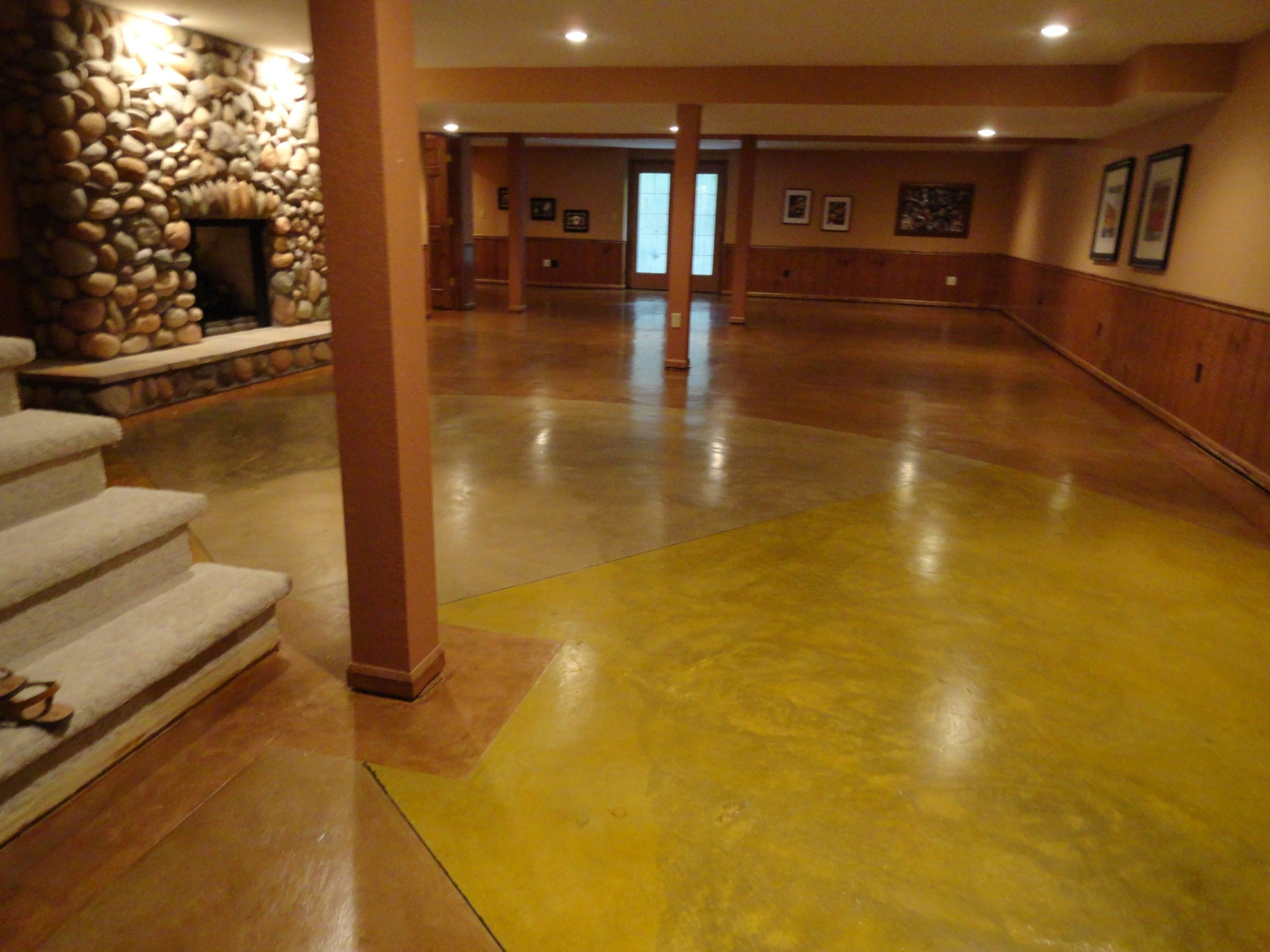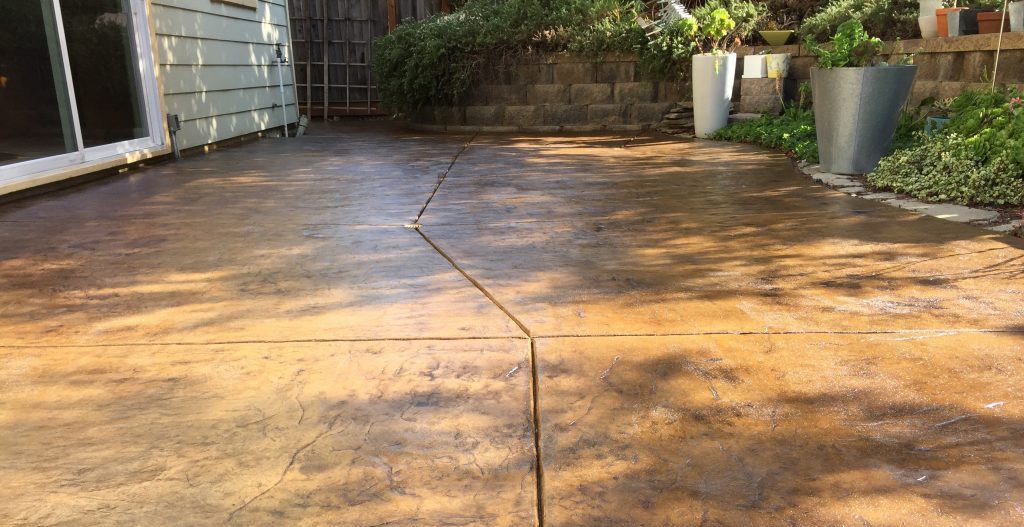The top finishes for stained concrete floors austin tx
Wiki Article
Understanding the Various Kinds Of Stained Concrete for Your Next Task
Stained concrete deals different options that accommodate various visual and useful demands. Each kind offers distinctive qualities that affect the last look and longevity of the surface area. Understanding these distinctions is essential for anybody planning a task. From rich, chain reactions of acid-based stains to the vivid harmony of solid color stains, the selections can substantially influence the result. What elements should one consider when selecting the ideal tarnish for their particular needs?Introduction of Stained Concrete
Stained concrete works as a flexible flooring option that can boost the aesthetic appeal of different spaces. This technique entails using a coloring representative to the surface area of existing concrete, permitting a wide range of layout possibilities. Stained concrete is prominent in both property and commercial atmospheres, using a durable and low-maintenance option that can simulate the look of all-natural products like rock or floor tile.The staining procedure can be implemented making use of water-based or solvent-based products, each supplying unique aesthetic effects. The final look is affected by aspects such as the initial concrete surface, the sort of stain used, and the application method. Stained concrete not only improves exterior and interiors yet additionally advertises sustainability by revitalizing existing concrete structures. Therefore, it has obtained traction among homeowners and developers seeking both performance and style in their floor covering choices.
Acid-Based Stains: Characteristics and Benefits

One-of-a-kind Shade Variants
Concrete surface areas can change drastically with the application of acid-based stains, which use an abundant scheme of distinct color variations. These stains pass through the concrete, reacting chemically to generate lively planet tones that range from deep browns and reds to soft greens and blues. The resulting colors are frequently variegated, developing a natural, marble-like appearance that boosts the concrete's personality. Each application returns unique results due to variants in the concrete's structure and the discoloration technique utilized, making every project special. Furthermore, acid-based stains can be layered or integrated with other methods to develop personalized designs, allowing for individual expression. This adaptability makes acid-based stains a preferred choice for both household and industrial applications.Chain Reaction Described
While many factors add to the efficiency of acid-based stains, the underlying chain reaction play a crucial role in their one-of-a-kind characteristics and benefits. These stains mainly consist of water, acid, and metal salts. When applied to concrete, the acid reacts with the calcium hydroxide in the cement, developing a chemical transformation that leads to permanent color changes. The metal salts pass through the surface area and bond with the concrete, permitting a variety of hues and tones. This reaction not just boosts aesthetic charm however also offers sturdiness, making the color immune to fading and wear. Additionally, acid-based stains can develop a variegated surface that simulates natural stone, more boosting their popularity for attractive concrete applications.Surface Prep Work Value
Accomplishing suitable results with acid-based stains rests on complete surface prep work. This vital step assurances that the concrete surface is tidy, without contaminants, and properly profiled for optimal stain absorption. Any existing sealants, dirt, or oils can impede the chemical response that produces the desired shade and finish, bring about unequal or uneven outcomes.Prior to applying the discolor, the concrete must be mechanically cleaned or pressure cleaned, followed by a detailed inspection for fractures or flaws that might require repair work. Furthermore, confirming the surface area is sufficiently dried out will certainly enhance tarnish adherence. By prioritizing these primary procedures, the long life and vibrancy of acid-based stains can be greatly boosted, resulting in a much more aesthetically pleasing and resilient surface.
Water-Based Stains: Features and Benefits

Water-based stains penetrate the concrete, offering a much more translucent surface that highlights the natural structure and variants of the surface area underneath. They are offered in a vast variety of shades, permitting creative versatility in layout. Additionally, water-based stains are easier to published here cleanse up, calling for only water and soap, which streamlines the application procedure.
Their quick drying out time improves performance, making them a sensible option for both DIY fanatics and specialists. On the whole, water-based stains provide an attractive mix of aesthetic versatility and straightforward buildings, making them a prominent option for concrete enhancement projects.
Solid Shade Stains: Dynamic Options for a Vibrant Appearance
Solid color stains use an effective remedy for those seeking to develop a strong and vivid aesthetic on concrete surfaces. These stains supply an uniform coloration that can drastically improve the aesthetic charm of floorings, patios, and driveways. Readily available in a vast range of hues, solid shade stains permit creative expression, dealing with numerous layout preferences.One of the key advantages of solid shade stains is their ability to conceal imperfections, supplying a fresh and sleek seek to aging concrete - Austin Stained Concrete Floors. In addition, their formulation normally includes UV-resistant properties, making certain long life and shade retention even in severe climate problems
Application is straightforward, calling my link for marginal prep work of the concrete surface area. When used, solid shade stains can be sealed for added protection and luster, additional boosting their visual quality. With their lively options, strong color stains are an outstanding selection for those going for an impactful and natural style.
Semi-Transparent Stains: Achieving Deepness and Dimension
Semi-transparent stains use a special approach to boosting concrete surfaces by giving depth and measurement through different color choices. Understanding the application methods is necessary for achieving the wanted impact, while correct maintenance practices ensure durability. This section will certainly check out these key facets to make best use of the advantages of semi-transparent discoloration.Shade Options Available
A wide range of shade alternatives exists for semi-transparent stains, enabling house owners and designers to enhance the natural charm of concrete surfaces. These stains are available in a variety of shades, from natural tones like browns and terracottas to vivid colors such as blues and environment-friendlies. The semi-transparent nature of these stains allows the underlying concrete to reveal via, developing a special depth and measurement that can complement various layout aesthetic appeals. In addition, incorporating various colors can create customized shades, enabling a tailored seek each job. This versatility makes semi-transparent stains a prominent option for both indoor and outside applications, as they can balance with surrounding components while including aesthetic passion to simple concrete.Application Techniques Explained
To achieve the desired depth and dimension with semi-transparent stains, proper application techniques are important. Surface prep work is critical; the concrete should be clean and cost-free of any kind of impurities. This often involves power washing and repairing any type of fractures. Next, picking the right applicator, such as a sprayer, roller, or brush, can affect the final look. Sprayers allow for a more even application, while rollers can aid accomplish texture. It is very important to use the discolor in thin, even coats, allowing each layer to completely dry prior to including another. Manipulating the application method, such as varying stress or utilizing various tools, can develop special impacts. Securing the stained surface area improves the vibrancy of the colors while supplying defense.Maintenance Ideal Practices
Normal upkeep is necessary for preserving the elegance and integrity of surfaces treated with semi-transparent stains. To keep these surfaces, routine cleansing is important. Making use of a pH-neutral cleaner and a soft-bristle broom will aid remove dust and particles without damaging the stain. It is a good idea to avoid harsh chemicals, as they can deteriorate the tarnish's look. Furthermore, regular resealing every one to 3 years can protect against wear and fading. This process entails cleansing the surface completely and using a suitable sealant designed for stained concrete. Home owners should likewise check for any type of indicators of discoloration or damages and address these issues immediately to assure lasting vibrancy and sturdiness. Adhering to these best techniques will certainly enhance the total life expectancy of semi-transparent stained surface areas.Results and Strategies: Personalizing Your Stained Concrete
Personalizing stained concrete entails a selection of strategies that enhance both looks and capability. Amongst these methods, layering various tarnish colors can create depth and intricacy, permitting for special visual results. Techniques such as acid staining give a variegated appearance, while water-based stains offer a more uniform look.Additionally, including ornamental patterns, such as stenciling or inscription, can even more personalize the surface area, including intricate layouts that accommodate specific tastes. Texturing the concrete, whether with stamping or mop coatings, introduces responsive components that not just improve hold yet likewise improve visual rate of interest.
Applying sealers can amplify the color vibrancy and supply protection versus wear. Modification methods prolong beyond plain color; they can transform a conventional concrete piece right into a sensational prime focus, making it ideal for both property and commercial rooms. With careful option of results and methods, stained concrete can achieve an absolutely tailored look.
Maintenance and Longevity of Stained Surfaces
Although stained concrete surfaces are understood for their toughness and visual why not find out more appeal, preserving their integrity is necessary for making sure long life. Routine cleansing is important; sweeping and wiping with a pH-neutral cleaner aids avoid dust build-up and staining. In addition, applying a sealant every couple of years can protect the surface area from wetness, chemicals, and UV damages, consequently enhancing its life-span.It is additionally vital to deal with any cracks or chips quickly. Little repairs can mitigate more degeneration, preserving the visual and structural top quality of the surface area. For outdoor stained concrete, seasonal upkeep, such as eliminating snow and ice, is necessary to avoid surface area damage from freeze-thaw cycles.
Frequently Asked Concerns
Can I Discolor Existing Concrete Surfaces or Only Brand-new Ones?
The question of whether existing concrete surfaces can be stained emerges often. It is certainly feasible to stain both brand-new and old concrete, offered the surface is effectively ready and complimentary of pollutants for ideal attachment.For how long Does the Discoloration Process Typically Take?
The discoloration procedure generally takes one to 3 days, depending on variables such as surface preparation, kind of discolor, and weather condition problems. Austin Stained Concrete Floors. Healing time may extend beyond preliminary application, affecting the overall duration substantiallyIs Stained Concrete Safe for Outdoor Usage?
Stained concrete is typically safe for exterior usage, gave it is correctly sealed. This sealing protects versus dampness and UV damages, making certain durability and security, while additionally enhancing the visual charm of outside areas.Can I Apply Numerous Stain Layers for Various Effects?
Using numerous discolor layers can achieve varied results on stained concrete. Nonetheless, it is necessary to assure compatibility in between stains and permit appropriate drying out time between applications to prevent unintended reactions or discoloration.Exist Any Kind Of Shade Limitations for Stained Concrete?
Shade limitations for stained concrete mainly depend upon the kind of tarnish used, with water-based stains offering a wider combination contrasted to acid-based stains. Austin Stained Concrete Floors. However, achieving dynamic colors may need cautious choice and application methodsReport this wiki page